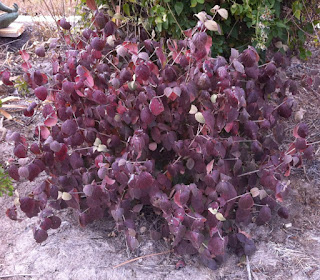 During my scavenging trip to the home farm, one of the garden items that I was going to bring back by hook or crook was the large ball pictured at the right. And now you're wondering, "what the heck is that thing?" And some of you are wondering, "how do I find one of those for my own garden?"
During my scavenging trip to the home farm, one of the garden items that I was going to bring back by hook or crook was the large ball pictured at the right. And now you're wondering, "what the heck is that thing?" And some of you are wondering, "how do I find one of those for my own garden?"This, my friends, is a hog oiler. As you can see in the picture below, it even says it's a hog oiler. Long ago, when people bought their bacon "on the hoof" rather than in vacuum-packed sanitary packages at the grocery, a local farmer was raising those pigs and most of those local farms had a hog oiler. You poured oil into the base of the oiler (plain old motor oil as I remember, in those halcyon days when we didn't realize that oil was toxic) and then the pigs rubbed against it to coat their skin with oil. Evidently pigs liked that. Oiling the hogs was supposed to keep the lice and other critters down on those free-range hogs, although its efficacy was questionable. Mostly, we got only oily hogs and oily hog pens from hog oilers.
 Our hog oiler was used on our farm until the late 1960's, after which it was retired along with the last pig and set to rust in a barn for 30 years. It's a very heavy cast iron model, evidently rare today because many of the cast iron ones were gathered up in WWII for scrap metal. If you want one, I understand they're quite pricey these days. My father resurrected it for his garden about 10 years ago, painting it black, but after a few years it went back to the barn to partially rust. When I got it 10 days ago, it merely looked like a neglected black ball.
Our hog oiler was used on our farm until the late 1960's, after which it was retired along with the last pig and set to rust in a barn for 30 years. It's a very heavy cast iron model, evidently rare today because many of the cast iron ones were gathered up in WWII for scrap metal. If you want one, I understand they're quite pricey these days. My father resurrected it for his garden about 10 years ago, painting it black, but after a few years it went back to the barn to partially rust. When I got it 10 days ago, it merely looked like a neglected black ball.I'd had my eye on this oiler for ages, sometimes lusting at the thought of putting it into my garden. I've avoided the glazing/reflecting ball cliche in my garden all these years because I can't stand the things, but this hog oiler is going to grace the center of my daylily bed as soon as I find a large enough pedestal to elevate it a bit. I've painted the ball silver, as you can see, hoping that it may reflect a little color and light in the Kansas sun, but if I tire of the shininess, I can always spray it back to matte black. Or let it rust. Rust would be perfect. I'd be as happy as a pig in, well, oil, if my hog oiler would rust all at once. I've got a shiver running right up my spine as I think of a big rusty ball as a centerpiece to my garden. God knows why, but you feel it too, don't you?
.jpg)




.jpg)



.jpg)
.jpg)
.jpg)
.jpg)








.jpg)


.jpg)
.jpg)
.jpg)
.jpg)
.jpg)
.jpg)

.jpg)







.jpg)
.jpg)
.jpg)
.jpg)
.jpg)
.jpg)
.jpg)